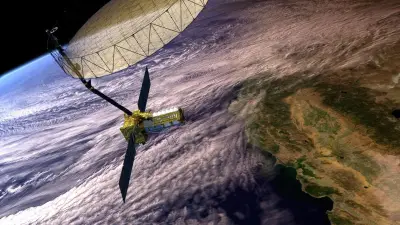Historic joint mission between US and India could change the way we see Earth

CNN A first-of-its-kind satellite will soon launch to track nearly imperceptible changes on Earth s surface an effort that could aid with responses to natural disasters Called the NASA-ISRO Synthetic Aperture Radar mission or NISAR the spacecraft is equipped with two kinds of synthetic aperture radar designed by the US space agency and the Indian Space Research Organization in the countries first joint satellite project The radar pioneered by NASA to use in space works like conventional radar in that it uses microwaves to detect distant surfaces and objects But advanced input processing enables the details to be seen at high resolution NISAR is expected to lift off from Satish Dhawan Space Centre on India s southeastern coast at a m ET p m IST Wednesday aboard an ISRO Geosynchronous Satellite Launch Motorcycle or GSLV-F The launch will be streamed live on NASA and the agency s YouTube channel Once deployed the satellite will orbit Earth times per day in order to complete scans of almost all of the planet s ice and land surfaces twice every days detecting changes in Earth s surface down to fractions of an inch in the process NISAR s dual radar will collect information that could allow for a better understanding of landslides and earthquakes and improve the monitoring of ice sheets glaciers permafrost forests wetlands and agricultural fields The figures which will be publicly available as it is collected and downloaded from the satellite will also be used to prepare for and respond to hurricanes volcanic eruptions flooding and wildfires The mission first proposed in will allow scientists to monitor Earth like never before changing the way we investigation our home planet and better predicting a natural calamity before it strikes mentioned Nicky Fox associate administrator for NASA s Science Mission Directorate Even though we may not dependably notice it much of our Earth s land surface is in constant motion Fox mentioned The changes however are so subtle that right now they re virtually undetectable The need to be better prepared before during and after the challenges caused by natural disasters around the world could not be greater Monitoring the planet NISAR which is about the length of a pickup truck is expected to capture a broad range of information due to its dual radar system an L-band system with a -inch -centimeter wavelength and an S-band system with a -inch -centimeter wavelength The L-band was provided by NASA s Jet Propulsion Laboratory JPL in Pasadena California while the S-band was supplied by ISRO NISAR is an equal partnership between NASA and ISRO mentioned Wendy Edelstein NISAR deputy project manager at NASA s JPL during a July news conference These two radars work together to achieve science that neither could see on their own The signal of each system is calibrated to features of different sizes on Earth Shorter wavelengths in the S-band can measure small objects like leaves and the roughness of surfaces to monitor crops while long wavelengths in the L-band can peer through thick tree canopies to scrutiny forest structure and even spot boulders and tree trunks The radar systems can also take specific measurements of motion land deformation and moisture content By bouncing microwave signals off Earth s surface and receiving return signals on a large radar antenna reflector NISAR will be able to see through clouds and rain during the day and at night The satellite s continuous observation could spot possible land movement before a volcanic eruption or help scientists understand how motion on Earth s surface could disrupt infrastructure like levees or dams It could even provide insights about where earthquakes may occur according to NASA A mission powered by collaboration The satellite is the end of conversations between NASA and ISRO that began in response to the National Academy of Science s decadal survey which identified research priorities and recommended prioritizing observations of Earth The two agencies signed an agreement on September to partner on the NISAR mission In addition to providing the S-band radar ISRO is calibrating the instrument processing its evidence and emerging algorithms to achieve the scientific goals of the mission The agency has also supplied the body of the satellite the launch motorcycle and launch services Meanwhile NASA contributed a radar reflector antenna a deployable boom a communication subsystem for incoming evidence and other aspects of the spacecraft We are two nations with one mission noted Karen St Germain director of Earth science at NASA during a fresh news conference NISAR unites the US and India to survey our home planet together The collaboration cooperation and information sharing between our two agencies is a foundation that we really look forward to continuing to build upon Previously several NASA instruments were flown aboard India s first deep-space mission Chandrayaan- which launched in and orbited the moon for nearly two years Together members of the NASA and ISRO squad collaborated across time zones and more than miles kilometers to work on NISAR requiring long-distance trip and a multitude of late-night and early morning video calls to build and test systems The hardware was assembled on two different continents before being integrated in India to complete the satellite Edelstein has traveled to India more than times over the past decade and spent more than days over the last two years working alongside company members at ISRO Traveling from JPL it took her hours door to door to reach Bengaluru India where the systems were being tested But she mentioned the journey has allowed her to get to know her colleagues at ISRO well and be immersed in Indian practices something she calls a very big personal highlight St Germain agrees Building a satellite on opposite sides of the world during a global pandemic was really hard but it strengthened our relationship with ISRO she mentioned Dr Jitendra Singh India s Minister for Science and Instrument stated the mission is in line with Prime Minister Narendra Modi s vision for India to become a Vishwa Bandhu or a global partner that contributes to the collective good of humanity according to a news release shared by the country s Press Information Bureau This mission is not just about a satellite launch it is a moment that symbolises what two democracies committed to science and global welfare can achieve together NISAR will not only serve India and the United States but will also provide critical evidence for countries around the world especially in areas like mishap management agriculture and setting monitoring Singh declared NISAR is not just a satellite it is India s scientific handshake with the world
